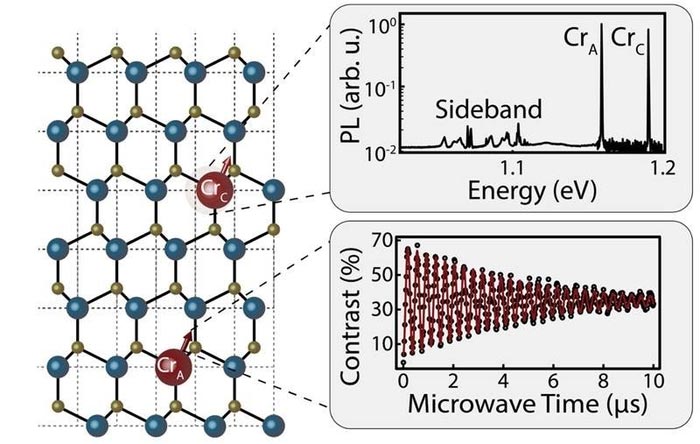New qubits bring us one step closer to quantum networks

Chromium atoms implanted into silicon carbide serve as spin qubits. The atoms occupy two sites in the lattice, which emit light at different wavelengths (top right). Oscillation in light emission from these atoms is a quantum property (bottom right).
Image courtesy of the University of Chicago
Chromium defects in silicon carbide may provide a new platform for quantum information.
The Science
Quantum computers may be able to solve science problems that are impossible for today’s fastest conventional supercomputers. Quantum sensors may be able to measure signals that cannot be measured by today’s most sensitive sensors. Quantum bits (qubits) are the building blocks for these devices. Scientists are investigating several quantum systems for quantum computing and sensing applications. One system, spin qubits, is based on the control of the orientation of an electron’s spin at the sites of defects in the semiconductor materials that make up qubits. Defects can include small amounts of materials that are different from the main material a semiconductor is made of. Researchers recently demonstrated how to make high quality spin qubits based on chromium defects in silicon carbide.
The Impact
Researchers are exploring chromium defects in silicon carbide as potential spin qubits. One advantage of these spin qubits is that they emit light at wavelengths that are compatible with telecommunications optical fibers. This means they are potentially useful for quantum networks that employ optical fiber to connect qubits. Unfortunately, issues with the quality of materials have limited these spin qubits’ viability. Researchers recently investigated new ways to make chromium defects in silicon carbide. They implanted chromium ions into silicon carbide then heated them to more than 1600 degrees Centigrade. This produced a material with spin defects that have a much higher qubit quality. This result could lead to quantum communications that use today’s semiconductor and fiber optic technologies.
Summary
A growing number of attempts to commercialize quantum computers and quantum sensors have invested heavily in specific types of qubits. However, researchers must overcome a number of challenges to realize practical quantum computing, communication, and sensing. For one, they need an improved understanding of the fundamental limits of various types of qubits. Spin qubits are particularly interesting because the electronic spin can store information for a long time compared with many other types of qubits. Moreover, these qubits can be operated at room temperature, and they can be controlled and read using optics. Optical interfaces will be important for the development of this technology since the photons can carry quantum information long distances using existing telecommunications fiber networks.
The research reported here showed that chromium ions implanted in commercially available silicon carbide substrates, and then annealed at high temperature, produced single spin defects that can be used for spin qubits. The same method could be used to create vanadium or molybdenum defects as researchers continue the search for the ideal qubit.
Funding
This project was supported by the Department of Energy (DOE) Office of Science, Basic Energy Sciences, Materials Sciences and Engineering Division. This work was performed, in part, at the Center for Integrated Nanotechnologies, a DOE Office of Science User Facility.
DOI: 10.1038/s41534-020-0247-7
Method of Research: Experimental study
Subject of Research: Not applicable
Article Title: Coherent control and high-fidelity readout of chromium ions in commercial silicon carbide
Article Publication Date: 29-Jan-2021
Media Contact
Michael Church
DOE/US Department of Energy
michael.church@science.doe.gov
Office: 2028416299
All latest news from the category: Information Technology
Here you can find a summary of innovations in the fields of information and data processing and up-to-date developments on IT equipment and hardware.
This area covers topics such as IT services, IT architectures, IT management and telecommunications.
Newest articles

New model of neuronal circuit provides insight on eye movement
Working with week-old zebrafish larva, researchers at Weill Cornell Medicine and colleagues decoded how the connections formed by a network of neurons in the brainstem guide the fishes’ gaze. The…

Innovative protocol maps NMDA receptors in Alzheimer’s-Affected brains
Researchers from the Institute for Neurosciences (IN), a joint center of the Miguel Hernández University of Elche (UMH) and the Spanish National Research Council (CSIC), who are also part of…

New insights into sleep
…uncover key mechanisms related to cognitive function. Discovery suggests broad implications for giving brain a boost. While it’s well known that sleep enhances cognitive performance, the underlying neural mechanisms, particularly…



